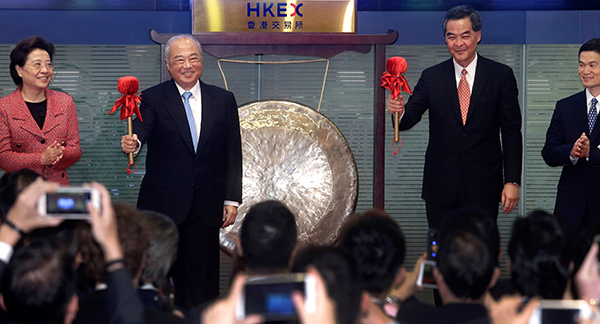'Through train' off to a slow start
 |
|
Leung Chun-ying (right), chief executive of the Hong Kong Special Administrative Region, and Chow Chung-kong, chairman of Hong Kong Exchanges and Clearing Ltd, ring the opening bell at the launch ceremony of the Shenzhen-Hong Kong Stock Connect on Monday. [Photo/China Daily] |
Connect program serves as bridge linking overseas and mainland investors
Overseas investors showed greater interest in Shenzhen-listed shares as the long-awaited, second cross-border stocks "through train" between Hong Kong and the Chinese mainland rolled off the tracks on Monday despite a slow start amid global economic uncertainties.
The kickoff of the Shenzhen-Hong Kong Stock Connect, which came just more than two years after the launch of a similar link with Shanghai, saw nearly 21 percent of the daily northbound quota of 13 billion yuan ($1.9 billion) being snapped up, while less than 10 percent of the daily southbound quota of 10.5 billion yuan was used.
Ceremonies were held simultaneously at the Hong Kong and Shenzhen bourses to mark the start of the new link, which heralds another giant leap forward in the nation's opening up of its capital markets.
Speaking at the ceremony in Hong Kong, Charles Li Xiaojia, chief executive of Hong Kong Exchanges and Clearing Ltd, said the Shenzhen connect will lead to more cross-border equity investment links.
He said the primary objective of the new "through train" is to build a bridge between overseas and mainland investors so that the mainland's wealth can be diversified and deployed globally through Hong Kong.
According to Li, the total cross-border market value of Hong Kong, Shenzhen and Shanghai has swelled to about 75 trillion yuan, making it the second-largest worldwide, adding that the Shenzhen link offers access to the "most creative and innovative" enterprises in the mainland.
He expects a series of other financial rollouts to follow, including links concerning exchange-traded funds, initial public offerings, bonds and commodities.
"The ETF is a very important next step underlying connect programs," he said, and it will allow Hong Kong access not only to mainland wealth, but also to a variety of sectors and industries from other regions to help in the country's diversification and the globalization of its wealth.
Many market analysts surveyed by China Daily reckoned that southbound investment will attract more capital inflow into Hong Kong.
Kinger Lau, managing director and chief China strategist at Goldman Sachs, said southbound investment should be well-anchored by potential further depreciation of the yuan, while the incremental southbound universe of small caps could offer value proposition.
Rocky Cheung, executive director and head of investment products and adviser at DBS Bank (Hong Kong) Ltd, however, said the upside 80 percent potential of A shares to be included in the MSCI Index this year, coupled with apprehension over the impact of US interest rate hikes on the Hong Kong stock market, would encourage more investors to invest northbound.
Thus, in the medium term, he forecast that A shares are likely to outperform their H peers.
Peter So, managing director of research at CCB International Securities Ltd, said the stagnant performance of the stock markets, which will probably last three months or so, is mainly due to the fact that the market had discounted the new stock link for some time and had well positioned themselves in the past few months, coupled with a volatile global economic environment and tightened liquidity.
The launch of the Shenzhen-Hong Kong Stock Connect was overshadowed by renewed economic uncertainties in Europe, arising from Italian Prime Minister Matteo Renzi's decision to quit after a referendum threw out his proposed constitutional reforms. It also saw the euro plummeting to 20-month lows against the dollar.
Hong Kong's benchmark Hang Seng Index shed nearly 60 points to close at 22,505.55 on Monday, while the Shanghai Composite Index lost 1.21 percent and the Shenzhen Component Index was down 1.18 percent at the close of trading.
Timeline for the connection
April 10, 2014 Premier Li Keqiang announced that the central government had approved the pilot programs enabling a connection between the stock markets in Hong Kong and the mainland.
Aug 26, 2014 The China Securities Regulatory Commission released a circular supporting Shenzhen's financial development. Proposal of the Shenzhen-HK Stock Connect Program submitted for review.
Sept 5, 2014 The CSRC said it supports deepened cooperation between the Shenzhen Stock Exchange and the Hong Kong Stock Exchange.
Sept 26, 2014 The Shanghai Stock Exchange released rules for the Shanghai-Hong Kong Stock Connect.
Nov 17, 2014 The Shanghai-Hong Kong Stock Connect launched.
March 5, 2016 The Government Work Report said the Shenzhen-Hong Kong Stock Connect will be launched "at an appropriate time".
Aug 16, 2016 The State Council approved the Shenzhen-Hong Kong Stock Connect proposal, and the launch of the program was well prepared.
Nov 15, 2016 Test trading of the Shenzhen-Hong Kong Stock Connect started.
Dec 5, 2016 Shenzhen-Hong Kong Stock Connection launched.























